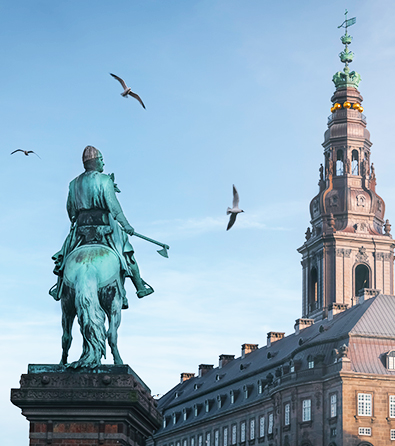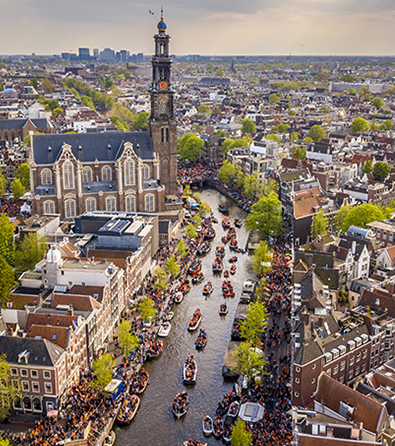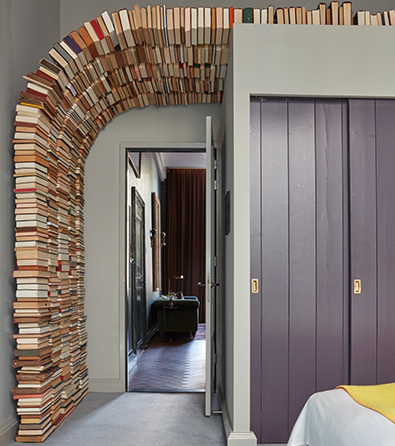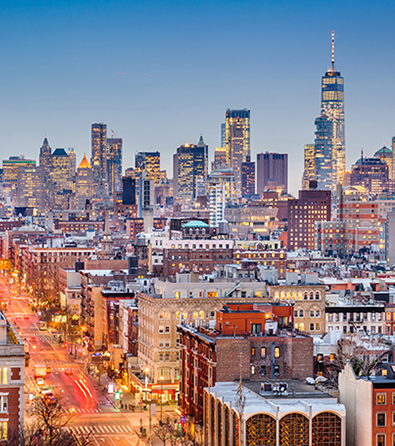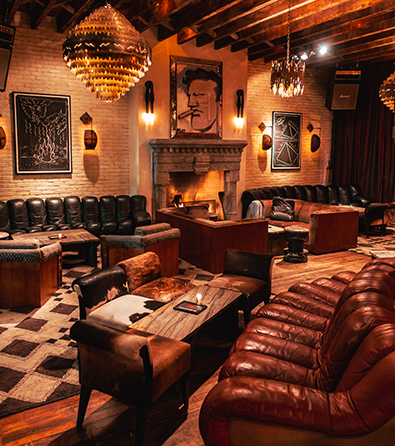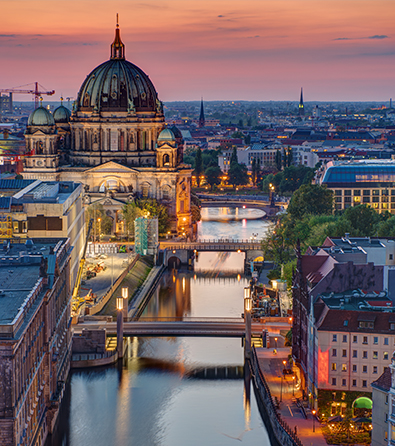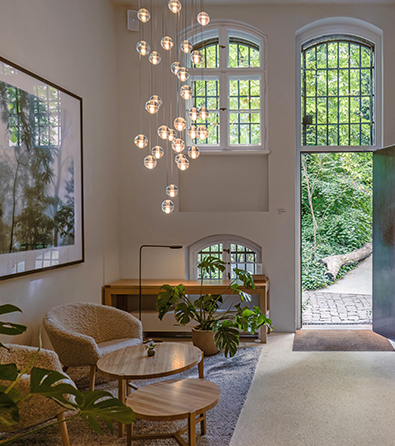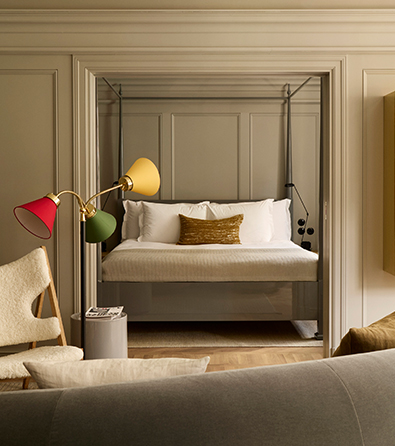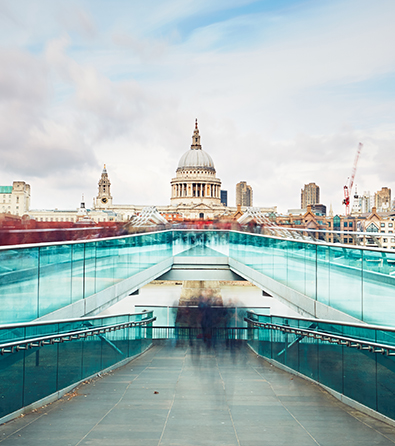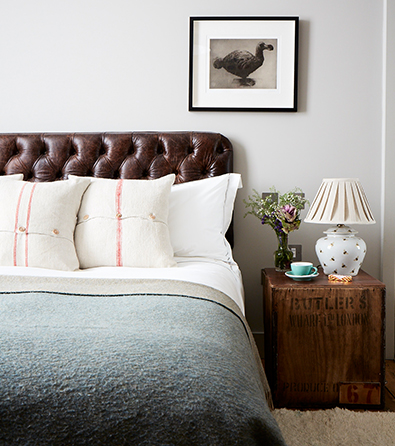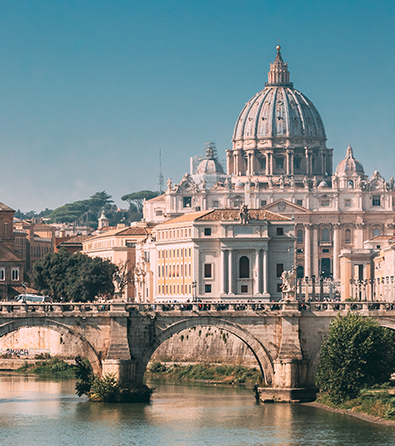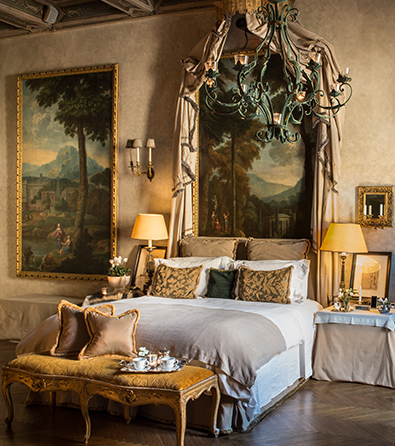New York is a world capital for art, design, and theater. This guide helps you plan an NYC culture trip with the best museums and galleries, landmark theaters, architecture icons, design shops, and neighborhood highlights. From Chelsea and the Lower East Side to Museum Mile and Broadway, use our insider tips and downloadable map to explore the city’s ever-evolving creative scene.
To access our exclusive NYC Treasure Map, simply click the attached link and become a Culture Treasures member. The map pins every place in this guide and adds bonus cafés, boutiques and cultural venues. Planning your stay? Explore our guide to the best design hotels in New York, along with our curated urban travel essentials and long flight essentials for a comfortable journey.
Art Museums:
Museum of Modern Art (Midtown / 53rd Street)
Why go: One of the world’s most influential collections of modern and contemporary art, reinstalled after a 2019 expansion that increased gallery space.
Tip: Start on Floor 5 for the icons and use MoMA’s free digital guide; reserve tickets in advance for peak times.
MoMA presents painting and sculpture alongside design, architecture, photography, film, and media/performance, with an evolving collection of almost 200,000 works. The Midtown campus combines the original Goodwin & Stone building with later renovations, most recently a 2019 renovation by Diller Scofidio + Renfro with Gensler that brought total gallery area to roughly 165,000 square feet and reshaped how visitors move through the museum.
New Museum (Lower East Side / Bowery)
Why go: Manhattan’s only museum devoted entirely to contemporary art, in SANAA’s stacked-box building on the Bowery.
Tip: The museum is temporarily closed for construction and is scheduled to reopen in fall 2025; when open, there is usually a Thursday pay-what-you-wish window from 7 to 9 pm.
New Museum was founded in 1977 to present new and under-recognized art, and it remains a non-collecting institution with a program that changes completely from show to show. The SANAA building opened in 2007. A 60,000 square foot expansion by OMA, in collaboration with Cooper Robertson, is underway to the south and will nearly double the footprint when it reopens in fall 2025. Expect exhibitions that engage current social, political, and cultural issues, plus the periodic New Museum Triennial spotlighting emerging practice.
Whitney Museum of American Art (Meatpacking District / High Line)
Why go: Museum at the south end of the High Line, focused on 20th and 21st century American art and living artists.
Tip: Book tickets in advance. Admission is free on Friday nights and the second Sunday of each month, and visitors 25 and under are free every day. Head to the upper terraces for Hudson River views and pair with a High Line walk.
The Whitney presents American art from the early 1900s to today, with a collection of more than 26,000 works by over 4,000 artists. Its building at 99 Gansevoort Street opened in 2015, designed by Renzo Piano Building Workshop with Cooper Robertson at the southern entrance to the High Line. Outdoor terraces connect multiple floors, and large column free galleries accommodate major exhibitions. The museum is known for the Whitney Biennial and for its mission to support living artists.
Solomon R. Guggenheim Museum (Upper East Side / Museum Mile)
Why go: Iconic spiral museum designed by architect Frank Lloyd Wright, with a soaring rotunda and ramp galleries focused on modern and contemporary art.
Tip: Start at the top and walk the ramp down. Reserve timed tickets for busy days. The museum sometimes offers pay-what-you-wish entry on select evenings.
The Guggenheim opened in 1959 and is defined by its helical ramp beneath a large skylight. The collection includes around 8,000 works, with strengths shaped by major private collections such as the Thannhauser bequest. Exhibitions often take over the rotunda for a single sweeping presentation, while side galleries and the annex host collection displays, talks, and education programs year-round.
The Metropolitan Museum of Art (Upper East Side / Museum Mile)
Why go: A world-class art museum with collections from ancient to contemporary across 5,000 years, beside Central Park.
Tip: Choose two or three sections per visit and use the map or app to plan your route. The seasonal Roof Garden offers skyline views, and New York State residents plus NY and NJ students can pay what they wish.
The Met was founded in 1870 and opened to the public in 1872. Its main building at 1000 Fifth Avenue holds major collections from ancient Egypt and classical antiquity to European Old Masters, American art, and African, Asian, Oceanic, Byzantine, and Islamic art, along with musical instruments, costumes, textiles, and arms and armor. The museum also operates The Met Cloisters in Fort Tryon Park, devoted to medieval European art and architecture. Temporary exhibitions range from large retrospectives to contemporary and cross-cultural shows.
Brooklyn Museum (Prospect Heights / Eastern Parkway)
Why go: Major art museum with wide-ranging collections in a Beaux-Arts landmark, strong in Egyptian, African, American, and contemporary art.
Tip: Pair your visit with the Brooklyn Botanic Garden and Prospect Park next door, and check the calendar for special evening programs like First Saturdays.
Brooklyn Museum occupies a grand Beaux-Arts building by McKim, Mead & White on Eastern Parkway. Its collection numbers nearly 500,000 works, ranging from ancient Egypt and Africa to European and American art, as well as a robust contemporary program. Exhibitions often engage themes of social justice and community, reflecting the museum’s commitment to accessibility and civic dialogue.
Art Galleries:
David Zwirner (Chelsea / West 19th–20th Streets)
Why go: Mega-gallery with museum-scale spaces and blue-chip shows, often spanning multiple buildings on the block.
Tip: Shows can be split across West 19th and West 20th Streets, check both before you go.
Founded in 1993 in SoHo and relocated to Chelsea in 2002, David Zwirner now operates multiple New York venues and an international network. Recent years have featured major presentations by artists such as Yayoi Kusama, and the program ranges from contemporary to postwar masters with frequent large-scale installations.
Pace Gallery (Chelsea / West 25th Street)
Why go: Global gallery known for ambitious, cross-disciplinary shows, from painting and sculpture to light, tech and installation, in a purpose-built Chelsea HQ.
Tip: The main hub is on West 25th Street, with additional spaces next door; check which address your show is in.
Pace’s New York headquarters consolidates multiple galleries under one roof and anchors a program that includes leading contemporary artists and estates. Since 2021 Pace has represented Jeff Koons, reflecting its focus on high-profile, experimental and innovative exhibitions.
Gagosian (Chelsea & Upper East Side)
Why go: World-spanning gallery network staging major, museum-caliber exhibitions in multiple NYC locations.
Tip: Confirm the location, shows run simultaneously in Chelsea and on the Upper East Side.
Gagosian presents large, scholarly exhibitions and represents numerous major artists, including Damien Hirst; it has also mounted significant Jasper Johns shows in New York over decades. Expect big statements, extensive publications, and frequent rotations across its citywide footprint.
Lehmann Maupin (Chelsea / West 24th Street)
Why go: International gallery with a multidisciplinary program and a strong roster of global contemporary artists.
Tip: Pair a visit with a High Line walk, its Chelsea space sits steps from the park.
Founded in 1996, Lehmann Maupin shows forward-looking work across sculpture, painting, video, and installation, and operates additional spaces in Asia and Europe. Exhibitions often spotlight cross-cultural voices and new commissions alongside historical context.
Hauser & Wirth (Chelsea / West 22nd Street; Upper East Side)
Why go: Swiss gallery with a purpose-built, five-story Chelsea flagship and a classic townhouse uptown; shows range from contemporary to major estates.
Tip: Entry is free. Check both venues, big, rotating exhibitions often run in Chelsea while focused shows appear on East 69th Street.
Hauser & Wirth’s 36,000-square-foot building on West 22nd Street hosts large-scale presentations, while the Upper East Side townhouse offers intimate exhibitions. The gallery represents significant artists and estates, including Louise Bourgeois, with robust education and publishing programs.
CLEARING (Bowery / Lower Manhattan)
Why go: Influential platform for emerging and mid-career artists, long known for adventurous exhibitions and early career breaks.
Tip: The gallery moved from Bushwick to 260 Bowery. In August 2025 it announced it would close its New York and Los Angeles spaces, verify current status before visiting.
CLEARING’s New York program shifted from a large Bushwick warehouse to a Bowery storefront, continuing its material-driven, experimental shows and international roster. Its New York presence has been closely linked to cutting-edge, curator-favorite exhibitions.
Gladstone Gallery (Chelsea / W 21st & W 24th Streets)
Why go: Influential contemporary program with museum-scale shows, including major exhibitions by Matthew Barney and Anish Kapoor and New York representation of the Robert Mapplethorpe Foundation.
Tip: Check both Chelsea spaces. Exhibitions often span 530 West 21st Street and 515 West 24th Street; occasional projects appear at the East 64th Street townhouse.
Founded by Barbara Gladstone in 1980, the gallery operates multiple New York venues and an international network. The program ranges from postwar figures to leading contemporary artists, with frequent large installations and focused historical presentations.
Sperone Westwater (Lower East Side / Bowery)
Why go: Architecturally striking gallery by Foster + Partners with a distinctive “moving room” elevator, presenting postwar and contemporary art by artists such as Bruce Nauman and Richard Long.
Tip: The building sits at 257 Bowery near the New Museum. Check hours, then pair your visit with a Bowery gallery loop.
Founded in 1975 in SoHo by Gian Enzo Sperone, Angela Westwater, and Konrad Fischer, the gallery moved to its purpose-built Bowery home in 2010. It stages ambitious solo and thematic exhibitions across media.
Jack Shainman Gallery (Chelsea & Tribeca; plus The School, Kinderhook)
Why go: Gallery foregrounding global contemporary voices and social engagement, with a roster that includes El Anatsui, Nick Cave, Kerry James Marshall, and Hank Willis Thomas.
Tip: Confirm the location before you go. The gallery operates in Chelsea at 513 West 20th Street, a Tribeca space on Lafayette Street, and The School in Kinderhook for large-scale shows.
Founded in 1984, Jack Shainman presents exhibitions that connect art to culture and history across painting, sculpture, photography, video, and installation, alongside publications and public programs.
Greene Naftali (Chelsea / 508 West 26th Street)
Why go: Conceptually adventurous gallery with ground-floor and eighth-floor spaces, known for rigorous exhibitions by artists such as Rachel Harrison and Paul Chan.
Tip: Summer hours often run Monday to Friday. Take the elevator to the eighth floor and pair your visit with a High Line walk.
Established in 1995, Greene Naftali presents cross-disciplinary shows that often bridge painting, sculpture, video, and performance, with an active publishing and commissions program.
Design Museums:
Cooper Hewitt, Smithsonian Design Museum (Upper East Side / Carnegie Hill)
Why go: America’s national design museum with more than 215,000 objects spanning 30 centuries, housed in the historic Andrew Carnegie Mansion.
Tip: Reserve tickets in advance. The Arthur Ross Terrace and Garden is often accessible without an admission ticket when open, a good spot for a break.
Cooper Hewitt presents historic and contemporary design across product, graphics, textiles, wallcoverings, jewelry, ceramics, furniture, and digital work. Founded in 1897 as the Cooper Union Museum for the Arts of Decoration, it joined the Smithsonian in 1967 and opened to the public at the Carnegie Mansion in 1976. Galleries and interactive experiences encourage hands-on exploration, and the entire collection is digitized for browsing online.
The Museum at FIT (Chelsea / Seventh Avenue)
Why go: New York’s only museum devoted solely to the art of fashion, with more than 50,000 garments and accessories from the 18th century to today and acclaimed research-driven exhibitions.
Tip: Admission is free. Check current hours and look for the Fashion & Textile History Gallery, which regularly shows highlights from the permanent collection.
The Museum at FIT is part of the Fashion Institute of Technology, a SUNY college, and sits at Seventh Avenue and West 27th Street. Its collection spans clothing, accessories, and textiles across centuries and cultures, and its curators are known for smart thematic shows that connect fashion to history and everyday life. Programs include talks, tours, and publications that make the subject accessible to both enthusiasts and industry visitors.
The Noguchi Museum (Long Island City / Queens)
Why go: The world’s largest collection of Isamu Noguchi’s work in a serene indoor–outdoor museum and sculpture garden he designed.
Tip: Take the NYC Ferry Astoria route or the subway to Broadway, check current hours and timed entry, and pair your visit with nearby Socrates Sculpture Park.
The Noguchi Museum was founded by Isamu Noguchi in 1985 to present his sculpture, drawings, models, and design objects in a setting he conceived. Housed in a repurposed 1920s industrial building with a walled sculpture garden, the museum realizes Noguchi’s aim to integrate art, architecture, and nature. Galleries flow around an indoor–outdoor loggia and courtyard, creating quiet places for contemplation alongside rotating presentations drawn from the collection and archives.
Museum of Arts and Design (Columbus Circle / 2 Columbus Circle)
Why go: Contemporary and historic craft, art, and design with a focus on how artists and designers transform materials and processes.
Tip: Check the calendar for Thursday evening deals and programs, and don’t miss The Store at MAD for design-forward shopping.
MAD’s mission is to collect, display, and interpret innovation in craft, art, and design. Exhibitions span jewelry, ceramics, glass, textiles, furniture, graphics, and digital media, with a strong education program and artist studios that bring making into view. The museum sits at 2 Columbus Circle, a short walk from Central Park, and regularly runs special evenings and seasonal free nights.
Design Galleries:
Friedman Benda (Chelsea / West 26th Street)
Why go: Powerhouse gallery for collectible design that bridges art, design, and craft, showing influential figures alongside emerging talents.
Tip: Check the current exhibition and hours, then pair it with a High Line walk or a Chelsea gallery loop.
Friedman Benda was founded in 2007 by Marc Benda and Barry Friedman and anchors its program at 515 West 26th Street. The gallery presents boundary-pushing furniture and objects by a diverse roster that includes Ettore Sottsass, Ron Arad, Estudio Campana, Nendo, Misha Kahn, Joris Laarman, Faye Toogood, Wendell Castle, and more. Rotating solo and thematic shows spotlight new work, historical bodies of work, and cross-disciplinary collaborations that define today’s design discourse.
Carpenters Workshop Gallery (Midtown / Fifth Avenue)
Why go: International gallery for collectible design and functional art, presenting unique and limited-edition works that bridge art, craft, and design.
Tip: The New York space is on Fifth Avenue. It is typically open Monday to Saturday, 10:00 to 18:00. Check the current exhibition before visiting.
Carpenters Workshop Gallery operates a global program and New York outpost that showcases and produces innovative furniture and objects by established and emerging creators. Exhibitions spotlight meticulous craftsmanship and sculptural form, often developed in close collaboration with the gallery’s own production workshops. The Fifth Avenue venue stages rotating solo and thematic shows that push beyond traditional design categories and invite close, material-focused viewing.
R & Company (Tribeca / White Street & Franklin Street)
Why go: Leading gallery for historic and contemporary collectible design, bridging art, craft, and design across two Tribeca spaces.
Tip: Check hours before visiting. 64 White Street is typically open Monday to Friday 11:00–18:00 and Saturday 12:00–18:00; 82 Franklin Street is usually open Monday to Friday 11:00–18:00.
R & Company was founded in 1997 by Zesty Meyers and Evan Snyderman, evolving from R 20th Century into a platform that champions both rediscovered masters and new voices. The program spans museum-level historical presentations and new commissions, with a roster that has included figures such as Wendell Castle, Verner Panton, Joaquim Tenreiro, Sergio Rodrigues, the Haas Brothers, Rogan Gregory, Jeff Zimmerman, and more. Exhibitions rotate between 64 White Street and 82 Franklin Street, supported by an active publications and archives program.
Ateliers Courbet (Chelsea / Tenth Avenue)
Why go: Gallery championing master craftsmanship and collectible design, connecting contemporary designers with centuries-old workshops and manufacturers.
Tip: Visits are by appointment, Tuesday to Friday 10:00 to 18:00, at 134 Tenth Avenue. Check the current exhibition before you go.
Ateliers Courbet was founded in 2013 by Melanie Courbet to spotlight exceptional design and the cultural heritage behind it. Now based in Chelsea, the gallery presents limited editions and commissions that foreground process and materials, often developed with renowned artisans and historic makers. Its program spans more than 50 traditional crafts, from marquetry and glass to metalwork and upholstery, and regularly pairs contemporary creators with master workshops to produce new, museum-quality work.
Colony (Tribeca / West Broadway)
Why go: Cooperative design gallery and platform for independent designers across furniture, lighting, textiles, and objects.
Tip: Visit the street-level space at 196 West Broadway Monday to Friday 12:00–18:00 or by appointment; check the current exhibition or the Designers’ Residency showcase.
Colony was founded in 2014 by Jean Lin to champion small, independent studios through a cooperative gallery model. After a decade on Canal Street, it moved in 2024 to a larger Tribeca storefront that also supports programming, publishing, and strategy work. The gallery’s Designers’ Residency incubates emerging American talent with mentoring, studio resources, and public presentations, while regular exhibitions highlight process, craft, and new collectible design.
Superhouse (Chinatown / Walker Street)
Why go: New-generation gallery for art furniture and contemporary design, mixing emerging voices with rediscovered 1980s pioneers.
Tip: Visit 120 Walker Street, 6R. Open Tuesday to Saturday, 12:00 to 18:00. Check the current exhibition before you go.
Superhouse was founded by Stephen Markos in 2019 and began in a compact Chinatown space before expanding to a larger venue on Walker Street. The program bridges contemporary and historical work, with exhibitions that spotlight material experimentation and functional sculpture alongside surveys of American art furniture. Regular talks and special projects round out a schedule that invites close, design-forward viewing.
Emma Scully Gallery (Upper East Side / East 79th Street)
Why go: Contemporary collectible design gallery foregrounding master craftsmanship, material experimentation, and new commissions.
Tip: Visits are by appointment at 16 East 79th Street; check the current exhibition schedule before you go.
Emma Scully Gallery opened in 2021 in a 19th-century townhouse on the Upper East Side. The program connects designers with skilled makers to produce limited editions and site-specific presentations across furniture, objects, and textiles. Recent shows have highlighted process and technique alongside new work by emerging and established creators, continuing the gallery’s focus on thoughtful, material-driven design.
Atelier Jolie (NoHo / Great Jones Street)
Why go: Collaborative atelier founded by Angelina Jolie that focuses on repair, upcycling, and craft, set in the former studio building of Jean-Michel Basquiat.
Tip: It is a working space with an evolving program. The on-site café by Eat Offbeat is typically open Tuesday to Saturday, 11:00 to 18:00. Check current hours before you go.
Atelier Jolie opened in 2023 at 57 Great Jones Street as a community-minded workspace where tailors, pattern makers, and artisans collaborate with visitors on mending, alterations, and custom upcycling using leftover and vintage materials. The space also presents gallery projects and a small café run by Eat Offbeat, which employs refugee and immigrant chefs. The building itself is part of New York art history, once owned by Andy Warhol and home to Basquiat’s studio, which adds context to the atelier’s emphasis on making and cultural exchange.
Broadway Theater
Palace Theatre (Times Square / TSX Broadway)
Why go: Historic Broadway palace recently restored and reopened after being lifted 30 feet as part of the TSX redevelopment.
Tip: Check which production is in residence; crowds peak around curtain time on 47th Street.
New Amsterdam Theatre (Times Square / 42nd Street)
Why go: Lavish 1903 house restored to its Art Nouveau glory and long-time home of Disney’s Aladdin.
Tip: Arrive early to enjoy the lobby details; theatre tours are paused at times, so check ahead.
Richard Rodgers Theatre (Theater District / 46th Street)
Why go: Home of Hamilton since 2015, a classic Broadway playhouse with excellent sightlines.
Tip: Timed entry and security can slow the queue; leave extra time around curtain.
St. James Theatre (Theater District / 44th Street)
Why go: Grand musical house with landmarked interior, home to long-running hits like The Producers and the original Hello, Dolly!
Tip: For photos, step across 44th Street to capture the full marquee.
Booth Theatre (Theater District / 45th Street)
Why go: Intimate Broadway playhouse known for powerful plays, including Next to Normal and the 2018 revival of The Boys in the Band.
Tip: Seats feel close to the stage; aim for front mezzanine for balanced views.
Off-Broadway & More
The Public Theater (NoHo / Lafayette Street)
Why go: Downtown incubator that launched Hamilton and Fun Home, plus Free Shakespeare in the Park.
Tip: For Shakespeare, use the digital lottery or in-person line; winter shows are inside at Astor Place.
Signature Theatre (Hell’s Kitchen / 42nd Street)
Why go: Playwright-centered seasons in a modern complex with affordable ticket initiatives.
Tip: Check which of the three spaces your show is in; lobby galleries often feature process materials.
La MaMa (East Village / E 4th Street)
Why go: Off-Off Broadway pioneer for experimental work since 1961.
Tip: Programs change quickly; verify which building your show uses on the 4th Street arts block.
Dance & Performance Arts
The Joyce Theater (Chelsea / 8th Ave at 19th Street)
Why go: NYC’s leading home for dance, presenting everything from ballet and contemporary to flamenco.
Tip: Many runs are one or two weeks; book early and pair with a High Line stroll.
BAM, Brooklyn Academy of Music (Fort Greene, Brooklyn)
Why go: Performance art center presenting cutting-edge theater, dance, music, and film across several venues.
Tip: The BAM Strong campus is steps from the C and G trains; arrive early to explore the neighborhood.
Immersive & Tours
Immersive now: Punchdrunk’s Viola’s Room (at The Shed)
Why go: A sensory, barefoot journey from the creators of Sleep No More, running in 2025.
Tip: Timed entry, minimal belongings, and specific arrival instructions apply; check your confirmation email.
Broadway Up Close Walking Tours (Times Square base)
Why go: Actor-led walks that decode theater history and architecture block by block.
Tip: Morning tours beat the crowds; their Times Square storefront sells fun marquee-lamp souvenirs.
Street and Public Art:
The High Line (Meatpacking District to Hudson Yards / West Side)
Why go: Elevated park on a former freight rail line with gardens, city and Hudson River views, plus a year-round program of site-specific public art, including rotating monumental works on the High Line Plinth.
Tip: It’s free and open daily with seasonal hours. Start at Gansevoort Street or 34th Street–Hudson Yards, go early or late, and check the current High Line Art installations.
The High Line is a 1.45 mile elevated park designed by James Corner Field Operations with Diller Scofidio + Renfro and planting designer Piet Oudolf. Opened in phases since 2009, it threads through the Meatpacking District and West Chelsea to Hudson Yards with seating, overlooks, and plantings that recall the self seeded landscape that followed rail service. High Line Art commissions site-specific works across the park, from sculpture and murals to sound, video, and performance. The Spur at 30th Street features the High Line Plinth, a platform for rotating large scale commissions, while the 14th Street Passage often hosts video installations. Exhibitions change regularly, so each visit offers a different encounter with art in the city.
Bushwick Collective & beyond
Why go: Rotating large-scale murals turn Bushwick’s warehouses into an open-air gallery, with new works by international and local artists; DUMBO Walls adds curated pieces in Brooklyn under the Manhattan Bridge.
Tip: For Bushwick, take the L train to Jefferson Street and start at St. Nicholas Avenue and Troutman Street. Go early for photos, and check for the annual Bushwick Collective Block Party in early June.
The Bushwick Collective began in 2011 and now anchors NYC’s street-art scene with constantly changing murals. Notable contributors include Swoon, whose installations have appeared across Bushwick, color-forward muralist Jason Naylor, and Roberto Seminario (Sef1), whose recent portraits drew lots of attention. Murals refresh regularly, so each visit feels new. Elsewhere, the DUMBO Walls project features works by major names such as Shepard Fairey near the York Street station, another easy add to a street-art day.
Houston Bowery Wall (NoHo / Bowery & East Houston)
Why go: Curated mural wall with rotating large-scale works by global street artists, first made famous by Keith Haring in 1982.
Tip: It is outdoors and free. Go early for photos and expect change, since new murals are commissioned a few times a year.
The Houston Bowery Wall sits at the corner of Houston Street and the Bowery and has been a canvas for landmark street art since Keith Haring painted it in 1982. Goldman Properties acquired the site in 1984 and relaunched it as a dedicated art wall in 2008 with curator Jeffrey Deitch, commissioning new murals roughly every 6 to 12 months. Notable pieces have included Os Gêmeos’s 2009 mural and Banksy’s 2018 work highlighting the imprisonment of Turkish artist Zehra Doğan. The wall remains a dependable stop for fresh, high-profile street art in the city.
Biggie Smalls “King of New York” Mural (Bedford-Stuyvesant / Bedford Ave & Quincy St)
Why go: Two-story portrait of The Notorious B.I.G., painted in 2015 by Naoufal “Rocko” Alaoui and Scott “Zimer” Zimmerman, now a neighborhood landmark and photo favorite.
Tip: It is a residential corner. Go early, be respectful, and pair with a walk through Bed-Stuy’s historic brownstone blocks.
This 38-foot mural, created by the Spread Art NYC duo Rocko and Zimer, honors Bed-Stuy’s own Christopher Wallace. In 2017 the building owner planned to remove it during renovations, but local outcry and support from across the city helped keep the work in place. The piece remains one of Brooklyn’s most visited hip-hop tributes and an easy add to a street-art day in the neighborhood.
Charging Bull (Financial District / Bowling Green)
Why go: Iconic bronze by Arturo Di Modica that became a symbol of Wall Street after an unsanctioned 1989 installation.
Tip: It is outdoors and crowded from mid-morning. Go early, watch traffic, and be mindful of pickpockets.
Charging Bull was installed without permission outside the New York Stock Exchange in December 1989 as a “gift to New Yorkers” after the 1987 market crash. Police removed it the same day, and the city reinstalled it at Bowling Green a few days later, where it remains. The 7,100-pound sculpture is 8 feet high and 16 feet long in bronze.
Fearless Girl (Financial District / Broad Street at NYSE)
Why go: Kristen Visbal’s bronze of a young girl that highlights gender diversity in corporate leadership and has become a contemporary symbol.
Tip: The statue stands across from the New York Stock Exchange. Expect lines for photos and tighter security on weekdays.
Fearless Girl debuted facing Charging Bull in March 2017, commissioned by State Street Global Advisors to spark a conversation about women on corporate boards. After a temporary permit at Bowling Green, the city relocated the statue later in 2018 to Broad Street by the NYSE, where it continues to draw visitors and media attention.
Atlas (Midtown / Rockefeller Center)
Why go: Monumental Art Deco bronze designed by architect-sculptor Lee Lawrie with modeling by Rene Paul Chambellan, positioned opposite St. Patrick’s Cathedral.
Tip: Best photo is from across Fifth Avenue with the cathedral in the background. Evenings offer dramatic lighting.
Installed in 1937, Atlas depicts the Titan supporting an armillary sphere and is Rockefeller Center’s largest sculpture. The figure is about 15 feet tall, while the full work reaches roughly 45 feet and weighs around 14,000 pounds. It remains one of the city’s most photographed sculptures.
The Sphere (Lower Manhattan / Liberty Park at World Trade Center)
Why go: Fritz Koenig’s bronze that survived the 9/11 attacks, now sited in Liberty Park overlooking the Memorial and museum.
Tip: Enter Liberty Park via the Liberty Street Bridge for elevated views over the site. Late afternoon light works well for photos.
The Sphere originally stood at the center of the World Trade Center plaza. After 9/11 it was moved to Battery Park as a temporary memorial, then in 2017 it was relocated to its permanent home in Liberty Park above the 9/11 Memorial. The sculpture’s scarred surface is preserved as part of its history.
Central Park Monuments (Upper East & Upper West Sides)
Why go: See three beloved works of public art in one walk: José de Creeft’s climbable Alice, an ancient Egyptian obelisk, and the John Lennon memorial with the “Imagine” mosaic.
Tip: Start by the Met for Cleopatra’s Needle, continue south to Conservatory Water for Alice, then cross to West 72nd Street for Strawberry Fields. Early morning is best for photos.
Central Park holds more than 50 statues and monuments across its 843 acres. The Alice in Wonderland bronze by José de Creeft (1959) sits at the north end of Conservatory Water near East 74th–75th Streets and is designed for kids to clamber on. Cleopatra’s Needle is a red granite obelisk originally erected in Heliopolis around 1475 BCE for Thutmose III, later moved to Alexandria by the Romans and dedicated in Central Park in 1881; it stands just west of the Met. On the west side, Strawberry Fields near the West 72nd Street entrance is a five acre landscape memorial to John Lennon, centered on the “Imagine” pavement mosaic crafted by Italian artisans and gifted by the city of Naples.
Take a break:
Walking through New York City, where the streets are steeped in cinematic history, offers an exhilarating experience unlike any other. I recall strolling back to my apartment through Union Square, only to look up and see Spider-Man swinging high above, a vivid reminder of the city’s role as a backdrop to countless movie and TV scenes. For those who share a fascination with these iconic locations, why not explore them firsthand while indulging in some of the city’s most famous culinary offerings?
Grab a pastrami at Katz’s Delicatessen on the Lower East Side, made famous by When Harry Met Sally; swing uptown to Tom’s Restaurant in Morningside Heights, the real exterior of Seinfeld’s diner; try a classic slice at Joe’s Pizza in the West Village, Peter Parker’s delivery job in Spider-Man 2; stop at Onieals Grand Street in SoHo/Little Italy, the backdrop for Sex and the City’s “Scout” bar; join the cupcake queue at Magnolia Bakery’s original West Village shop from Sex and the City; and finish with dessert at Milk Bar, spotlighted on Netflix’s Chef’s Table with founder Christina Tosi.
Design Concept Stores:
Start at the MoMA Design Store across from the museum for a tightly curated mix of home goods, tech, kids items, and MoMA-exclusive designs. In Flatiron, ABC Carpet & Home is a multi-level trove of rugs, textiles, lighting, and artisan decor, with refreshed edits and vintage finds. On Lexington Avenue, Dover Street Market New York stacks floor after floor of avant-garde fashion, design objects, and in-store installations, plus a Rose Bakery for a quick break.
Chelsea Market (Chelsea / Ninth Avenue at 15–16 Streets)
Chelsea Market occupies a historic industrial complex redeveloped in 1997 into a ground-floor marketplace with offices above. Inside you’ll find dozens of food vendors, cafés, bakeries, seafood counters, and specialty shops, plus Artists & Fleas, an indoor marketplace of independent designers and vintage sellers. The building spans the block between Ninth and Tenth Avenues, and today it’s owned by Google’s parent company, with tech offices upstairs. It’s an easy pairing with a High Line stroll or a visit to Pier 57 and Little Island.
Vintage Stores:
Start at Beacon’s Closet for big, well-edited racks, with branches in Greenpoint (flagship), Park Slope, Bushwick, and Greenwich Village. For luxe designer finds, What Goes Around Comes Around anchors SoHo with a flagship packed with hard-to-find pieces. Budget hunters can sweep L Train Vintage, a multi-location staple across Brooklyn and Manhattan known for affordable denim, workwear, and tees. In the East Village, AuH2O focuses on sustainable, small-batch vintage and upcycled picks. In Brooklyn, Awoke Vintage offers tightly curated selections in Williamsburg and Greenpoint. Round it out at The Vintage Twin, which runs a SoHo flagship and a Lower East Side shop for reworked and curated classics.
Vintage Design Stores:
Start at Demolition Depot in East Harlem for architectural salvage including doors, windows, mantels, ironwork, lighting, and stone pieces. In Flatiron, Furnish Green offers a tightly curated mix of vintage and antique furniture and decor with a sustainable, small-batch approach. Round it out at Olde Good Things, whose Midtown West flagship showcases reclaimed architectural elements and vintage furniture sourced from notable New York buildings, with additional locations and larger stock in its warehouses.
And Beyond:
TWA Hotel (JFK Airport / Terminal 5)
Why go: The TWA Flight Center, designed by architect Eero Saarinen in 1962, is reborn as a retro-modern hotel with a public lobby, period bar, and small exhibits celebrating the golden age of air travel.
Tip: Take the JFK AirTrain to Terminal 5. The lobby and museum displays are free to visit without a room reservation. The rooftop pool is seasonal and requires a separate reservation.
The restored TWA Flight Center, designed by Eero Saarinen in 1962, now serves as the hotel’s soaring lobby with the Sunken Lounge and the Paris Café by Jean-Georges. A 1958 Lockheed Constellation on the tarmac houses the Connie cocktail lounge. Curated displays present TWA uniforms, posters, and memorabilia. Two new hotel wings sit behind the landmark terminal, preserving the dramatic thin-shell roof and sweeping interiors, making this one of New York’s most photogenic design pilgrimages even for non-guests.
Vessel (Hudson Yards / Public Square & Gardens)
Why go: Climbable landmark of interlocking stairs by Heatherwick Studio with river and skyline views, reopened with new safety barriers.
Tip: Timed tickets are required. The top level remains closed and some upper sections are restricted. NYC residents can visit for free on Thursdays with advance reservation.
Vessel is a 16-story, 150-foot structure made of connected staircases and landings. After closing in 2021, it reopened in October 2024 with floor-to-ceiling safety mesh and additional barriers on upper levels. Access is focused on the lower tiers, with movement limited higher up. Combine a visit with the High Line or the observation deck at Hudson Yards for broader city views.
Central Park North Woods (Upper West Side / 101st–110th Streets)
Why go: The park’s wildest corner with woodland trails, waterfalls, rustic bridges, and the historic Blockhouse fort.
Tip: Enter near West 103rd Street or West 110th Street. Wear good shoes and bring a picnic for the Great Hill; mornings are best for birdwatching.
The North Woods occupies about 40 acres in the northwest of Central Park. Its Ravine shelters the Loch, a narrow stream with three waterfalls that begins at the Pool and flows toward the Harlem Meer under stone arches and footbridges. On a schist outcrop above the woods stands the Blockhouse, a War of 1812 fortification and the park’s oldest surviving building. Just south, the Great Hill rises to about 135 feet above sea level and offers a lawn with picnic tables and wide views.
9/11 Memorial & Museum (Lower Manhattan / World Trade Center)
Why go: National memorial with twin reflecting pools in the Twin Towers’ footprints and a museum that documents the 2001 attacks and the 1993 World Trade Center bombing.
Tip: The Memorial plaza is free and open daily. The Museum requires timed tickets and airport-style security. Go early or late for quieter crowds and allow 90 to 120 minutes.
The Memorial, designed by Michael Arad with landscape architect Peter Walker, centers on two voids with cascading waterfalls; bronze parapets around the pools bear the names of those killed in 2001 and 1993 arranged by meaningful adjacency. The Museum lies beneath the plaza and presents artifacts such as the façade tridents, the Survivors’ Stairs, and the Last Column alongside oral histories, images, and film. A private repository within the site houses unidentified victims’ remains under the care of the city’s medical examiner and is not open to the public.
With the interactive map below, you can compare all available accommodation options in the city and find the best prices from a variety of leading providers.












